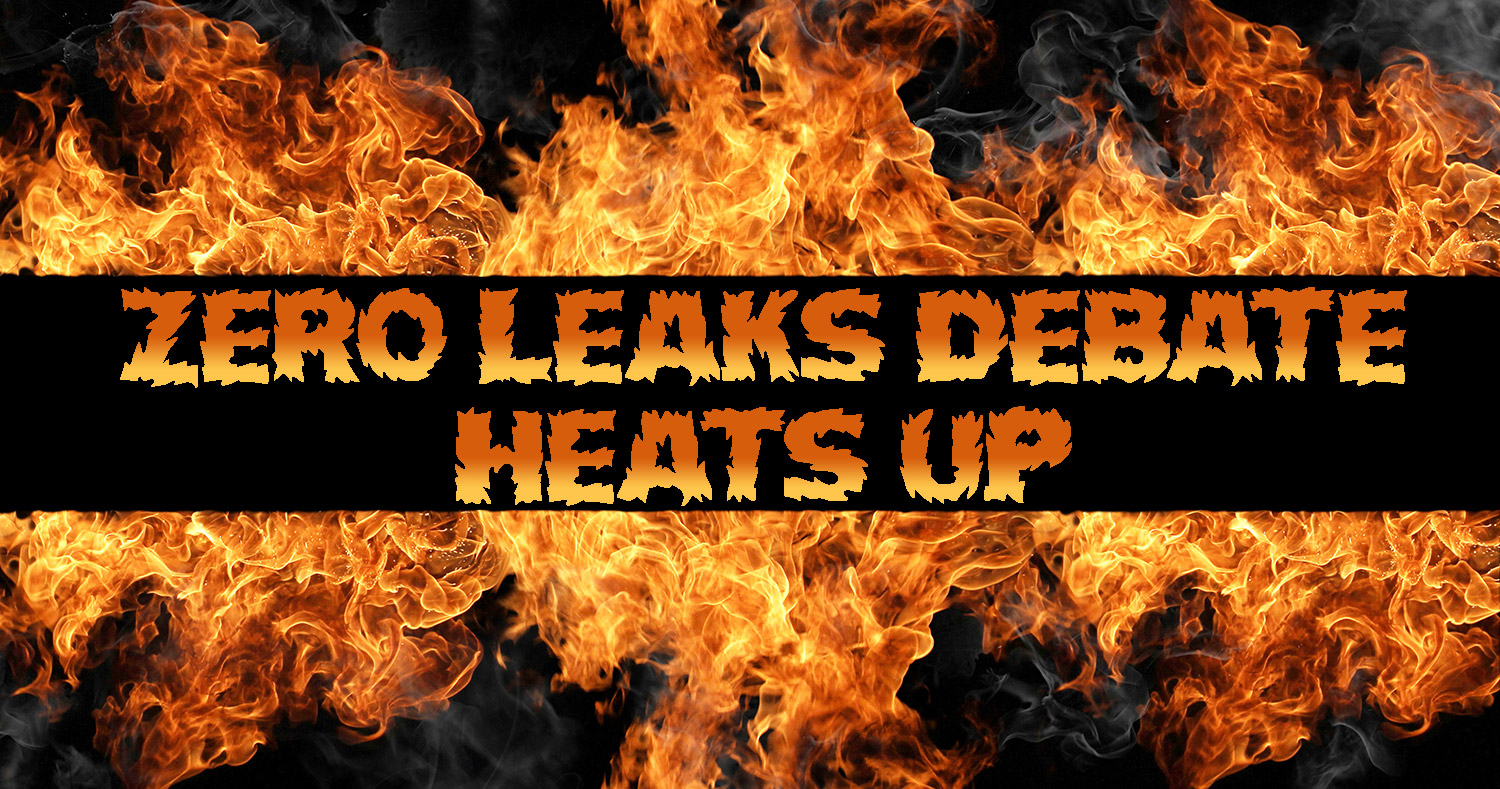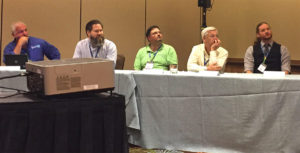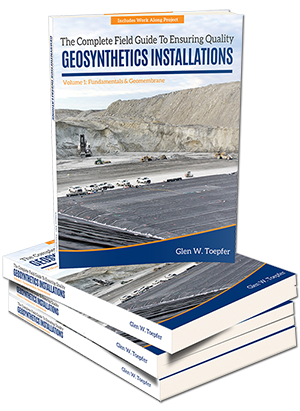
Late winter has certainly provided a lot of heat from debate being stirred in the geosynthetics industry here in the United States.
First, there was the resonating “ka-boom” felt when Dr. Bob Koerner announced that geomembranes should lie flat, followed several weeks later by a heated discussion between some panel participants and the audience at Geotechnical Frontiers 2017 conference.
I was privileged to be invited to participate in that zero leaks panel discussion. Industry conferences such as Geotechnical Frontiers are a great way to learn about new methods and technologies, hear success stories of projects highlighting the innovative uses of geosynthetics, share and transfer knowledge, and catch up with industry friends and colleagues from around the world.

Geotechnical Frontiers 2017 Panelists (from left to right): John Heap (Colorado Lining Inc.), Matthew Kemnitz (Leak Location Services, Inc.), Glen Toepfer (CQA Solutions, LTD.), Rick Thiel (Thiel Engineering), and Carl Charpentier (Group Alphard). Photo courtesy of Carl Charpentier.
Normally, I try to catch a bunch of the plenary and technical sessions, attend special events, and squeeze in the trade show floor in order to keep abreast of the latest and greatest in our industry. Unfortunately, my time at the show was rather constrained due to other obligations and scheduled meetings. My travel schedule has been quite hectic as of late and that will continue through at least mid-April.
Based on my observations and conversations with colleagues, the show did not disappoint – certainly our panel discussion did not disappoint. Assembled by respected industry professional Tim Bauters of Golder Associates, Inc., the panel discussion “How to Design your Containment System for Zero Leakage by including Geoelectric Integrity Tests” brought together industry veterans Rick Thiel (Design), John Heap (Installation), myself (CQA), andCarl Charpentier and Matthew Kemnitz (Electric Leak Location) as panelists. This discussion was well attended by individuals with a broad spectrum of knowledge within the industry, ranging from college students to industry icons such as Dr. George Koerner and Dr. Ian Peggs.
Should Zero Leaks Be The New Action Leak Rate (ALR) Standard?
I always feel that audience participation is key to a successful panel discussion, and this panel discussion did not disappoint in that regard. One of the most spirited debates was whether containment systems should actually be designed on the premise that there will always be leaks, or whether the system should be designed for zero leaks. While zero leaks is clearly achievable (as discussed in numerous case studies over the past several years) the debate rages as to whether that should be considered the achievable norm.
And, there are plenty of industry papers available in that regard, submitted in various forums over the past few years. My personal belief is a mixed bag, because in certain instances, zero leaks is clearly achievable. However, caution must always be used that regulations are not so strict that they end up compromising long-term quality for a short-term gain.
Zero Leaks – How Long Does It Last?
Another follow-up point to that debate is the longevity of zero leaks. Will a project with zero leaks at the time of certification actually remain leak free over its operational lifetime? Much of that is felt to rely on the operations component, although proper design, materials, and workmanship during installation are also key to success in this regard. The Palo Verde Nuclear Generation Station evaporation ponds are still leak free seven (7) years after completion of the installation, so it is possible. But is it probable?
Let’s think about the steps involved in that for a moment:
- Regulatory requirement often governs the design, but an owner ultimately sets the goal and tone for the project.
- Owner sets the achievement goal and is involved in vendor/material selection process and every stage thereafter to hold accountability to that goal.
- Design engineer selects proper materials, and provides a design that is constructible in the field, with current, relevant specifications that to not hinder quality.
- Construction Quality Assurance (CQA) firm needs to be analytical, and proactive in developing/following the CQA Plan that should be site/project specific.
- Installer needs to use proper installation methods that do not damage the geomembrane and also are performed such that long-term performance is not jeopardized. Internal QC needs to be aggressive and proactive in addressing any issues and should have work-stop authority.
- Field CQA team needs to be competent and not only understand the installation process, but also needs to understand the electrical leak location methods to ensure the best chance of success.
- Leak location team needs to be competent and knowledgeable, as well as having everything set up properly such that the testing will actually work and perform properly.
- Post-construction damages do not occur during the operation life cycle, or if they do, they can be identified and repaired.
On the surface, it seems like a lot of things have to fall in place and be taken into consideration for zero leaks to occur and that is true. But it has been proven repeatedly that it can be done. I believe that owners should set their goal for zero leaks, even if regulations call for less, and that all of us in the industry have an obligation to do our best to protect the groundwater and other valuable resources. The technology and capabilities are there! But is it there for the long-term?
Zero Leaks Post-Construction and Certification
Currently, there is often a gap (or even open-endedness) upon completion of the installation. In many instances construction is completed, followed by a certification report submitted for agency review shortly (usually 1-2) weeks after completion. The agency then has a set timeframe to review and approve the certification report, which could range from a couple weeks to a couple months.
Therefore, from the time the project is completed to the time the system is made operational may be weeks to several months. Often, there is no follow-up strategy for inspection prior to the system becoming operational, meaning any damages that may have occurred post construction (animals, vandalism, weather, etc.) will remain in place when the system becomes operational. Why do owners, certifying engineers, and regulators not require some sort of final walk through immediately prior to the system becoming operational?
Operational Lifetime Inspection and Maintenance
Likewise, there is often no maintenance or inspection plan in place after the system becomes operational. John Heap offered a great suggestion in this regard: Upon completion of the construction, the owner should be given a recommended inspection and maintenance plan that they can follow throughout the life cycle of the system.
Other Considerations
There were definitely other important tidbits thrown out during our panel discussion that deserve consideration and forethought as this industry moves forward. Some of these are:
- Leak location should be incorporated as part of the planning and design stage, and accounted for during installation through both installer Quality Control and third-party Quality Assurance.
- In some instances, leak location may not work, depending on design, installation, and operational considerations.
- The percentage of projects actually using leak location is still very low, even though there are plenty of international case studies showing the success of this technology when properly incorporated into the project.
- CQA involvement is not only at the field level, but should be involved or at least thought of at all stages of the project.
If you attended our panel discussion, thank you! Please feel free to provide additional feedback that I may have missed, or share your thoughts on these issues. Likewise, if you were not able to attend Geotechnical Frontiers 2017, or if you were not able to attend our panel discussion, I offer the same venue for you to share your thoughts.
I look forward to hearing from you!



